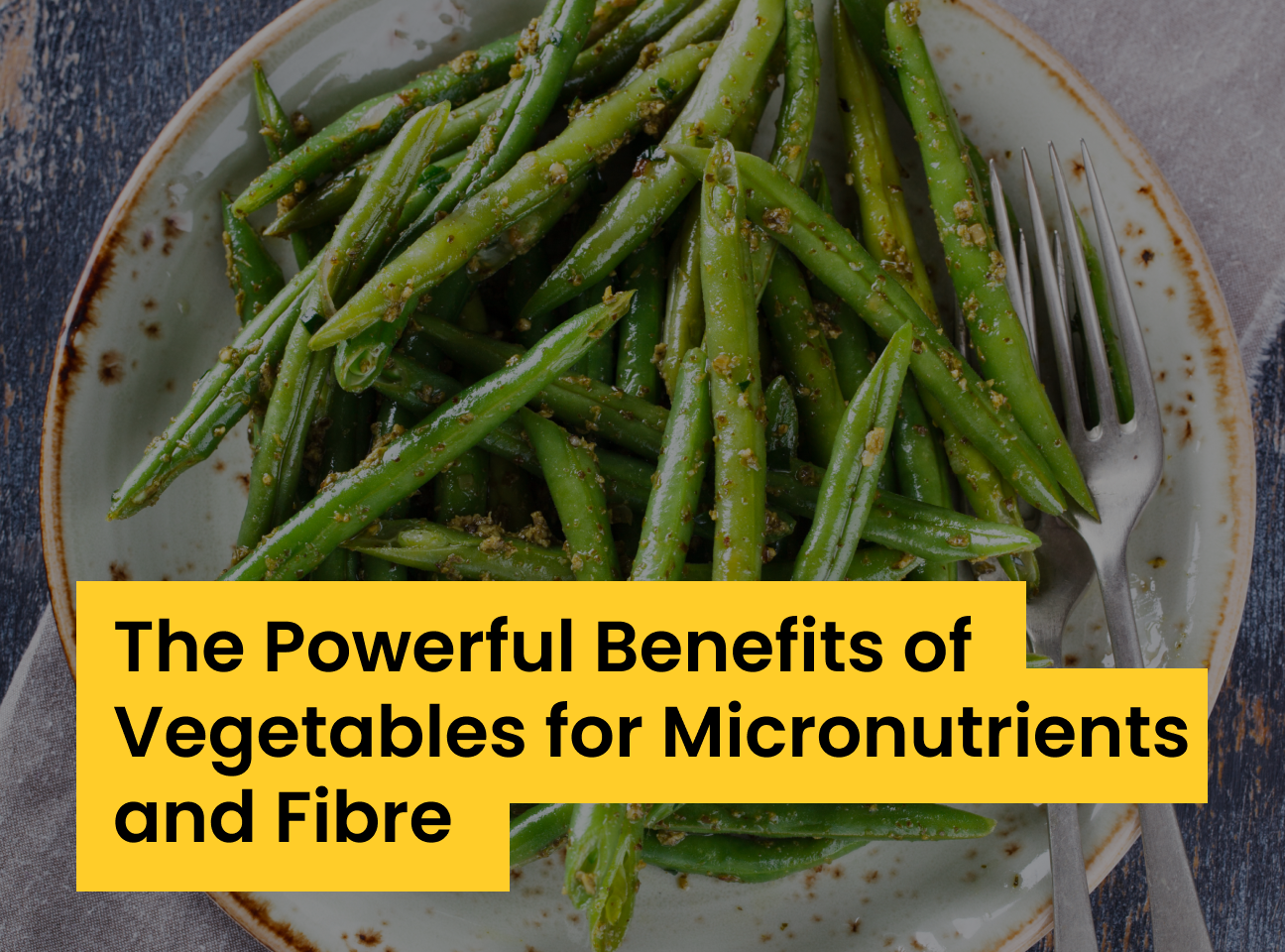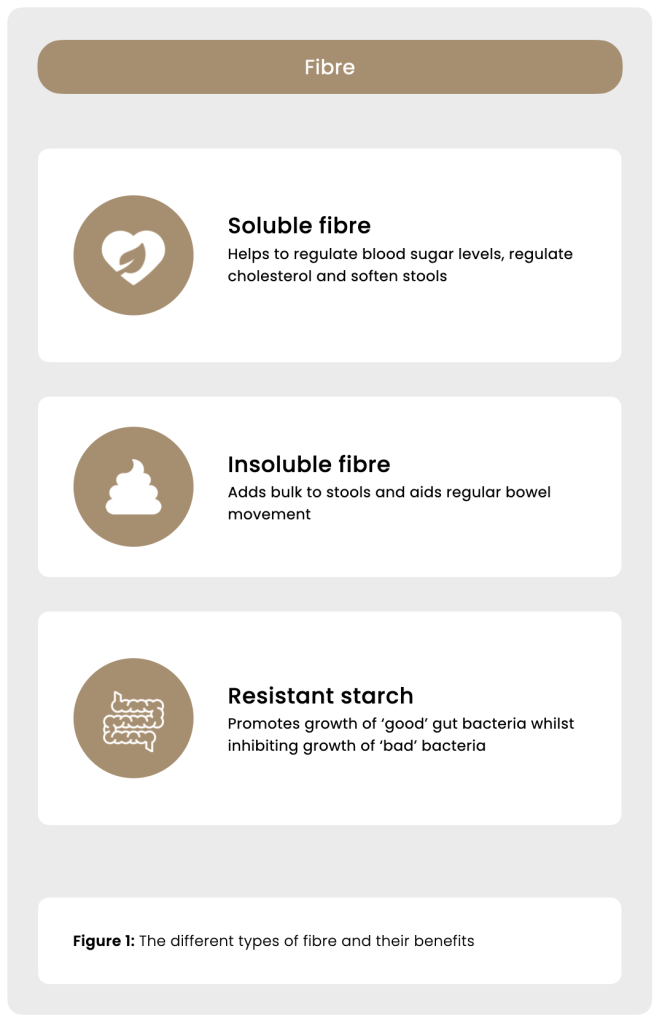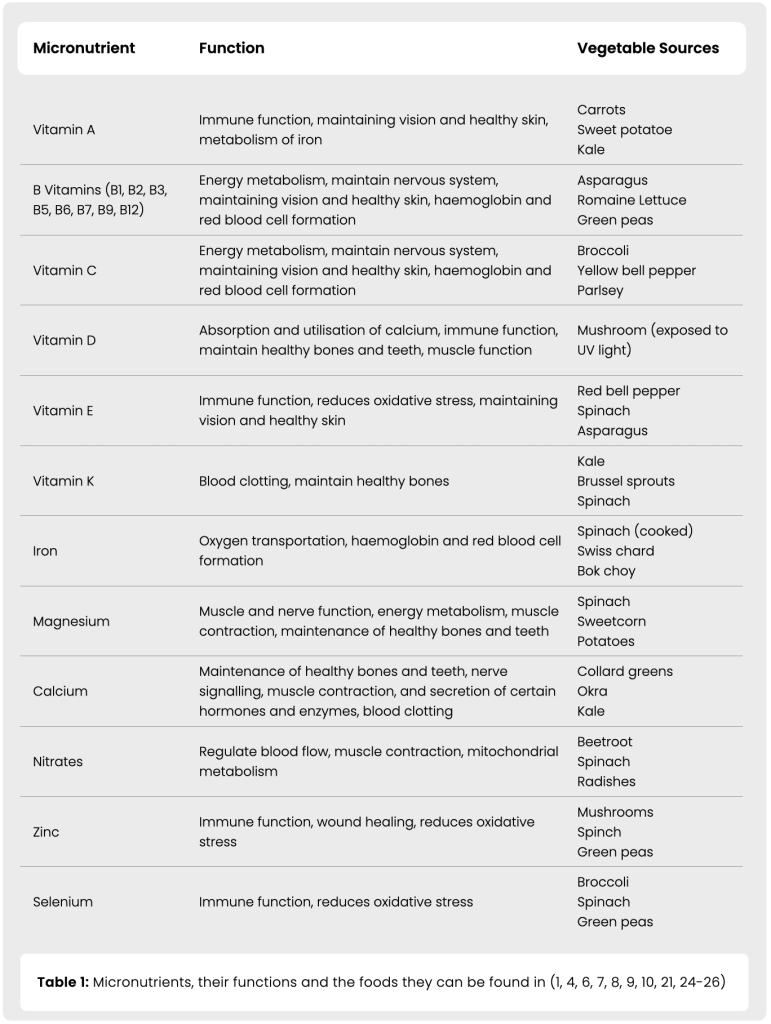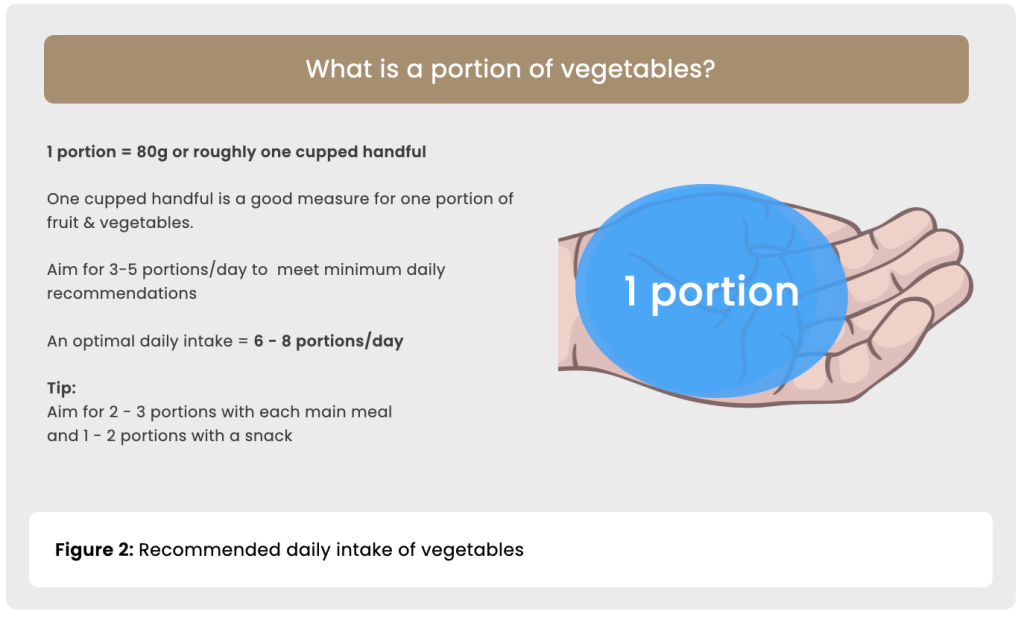
The Powerful Benefits of Vegetables for Micronutrients and Fibre
By Nina Walker MSc, DipIOPN, BSc, SENr, UKAD

It is well understood that the daily consumption of vegetables positively contributes to a healthy diet and supports athletic performance (1-4). With athlete’s and active individuals having higher rates of energy metabolism and a greater demand on their bodies to perform, their requirements of the various nutrients vegetables provide can be much greater than the average person (4-6).
Vegetables provide great sources of essential nutrients including vitamins, minerals, fibre and carbohydrates. These nutrients are crucial for a number of metabolic and physiological processes in the body such as turning food into energy through metabolic pathways, the synthesis and repair of new muscle tissue, protection against oxidative stress, support to the production of oxygen-carrying proteins, maintenance of bone health, support to the immune system, and maintaining fluid balance (1, 3, 4, 6-10).
Vegetables also help contribute to feelings of enjoyment, satisfactions and fullness with their inclusion in the diet contributing towards an individual’s ability to maintain a healthy weight (11, 12).
Insufficient intakes of vegetables and the nutrients they provide can contribute to poor health and nutritional deficiencies which can affect an individual’s physical and mental performance and recovery. Nutritional deficiencies can lead to greater occurrences of fatigue, a higher risk of illness or injury, longer recovery periods and impaired immune function (1, 4, 8, 10).
Fibre
Fibre is an essential component to a healthy and balanced diet. It supports gut health and the bacteria that live in the gut, ensures regular bowel movements and can provide protective mechanisms to overall health such as supporting cardiovascular health, weight management and preventing diseases such as diabetes and colorectal cancer (2, 3, 13-15).
Vegetables are a great source of fibre and provide three different types; soluble, insoluble and resistant starch (Figure 1).
Considerations
If increasing vegetable intake, do it gradually and ensure enough fluids are being regularly consumed throughout the day to offset any potential gastrointestinal symptoms such as gas, bloating, diarrhoea or constipation which can be caused from an increase in food volume and fibre content.
Fibre increases satiety and slows down the digestion of food in the stomach so vegetables rich in fibre should be avoided in the meals consumed around exercise. If eaten too close to exercise, they can cause symptoms of gastrointestinal distress. Instead, fibre-rich vegetables should be prioritised in the meals further away from exercise.
Consuming large quantities of vegetables and fibre can have a satiating effect which can make it more difficult to eat sufficient calories, especially if energy demands and high. This can lead to an unintentional reduction in energy intake and if ongoing, this reduction in energy intake could lead to being in a state of low energy availability (LEA) and relative energy deficiency syndrome (RED-S) (16, 17).
Micronutrients
Micronutrients, such as vitamins, minerals and antioxidants, are compounds that cannot be synthesised by the body so it’s essential that sources of them are included through the diet.
Although only small amounts are required, micronutrients play a vital role in maintaining a healthy, well functioning body. A lack of essential micronutrients can have detrimental effects on an individual’s health as well as their training, performance and ability to recover (9, 18-20).
Vegetables are excellent sources of vitamins, mineral and antioxidants and including a variety of vegetables in the diet is a great way to ensure micronutrients needs are being met. Different vegetables contain different micronutrients at varying levels so a varied intake ensures a broader spectrum of micronutrients are being consumed; the more variety there is, the more likely an individual’s dietary micronutrient intake needs can be met (2).
Micronutrients carry out some important roles in a number of reactions involved with exercise and recovery. These include energy metabolism, tissue repair, oxidative metabolism, immune function and oxygen transfer and delivery (9, 18, 21).
Exercise can induce small depletions of certain micronutrients so active individuals can have higher requirements than the general population. Some populations can also be at higher risk of developing nutrient deficiencies and might need to consider consuming more of the foods that can provide what they are lacking. For example, iron deficiency is common amongst exercising females (21-23) with the risk increased further if following a vegetarian or vegan diet and/or engaging in endurance-based exercise (23).
Considerations
The absorption of certain micronutrients can be increased by consuming certain foods at the same time. For example, the absorption of iron from non-haeme food sources such as cooked spinach, lentils and tofu can be increased when consumed with Vitamin C-rich foods such as orange juice (22). Foods containing fat soluble vitamins (A, D, E, K) can be better absorbed and utilised when eaten with a source of fat such as olive oil, oily fish or avocado (27).
The absorption of certain micronutrients can also be inhibited when consumed with some foods or drinks. For example, it is best to avoid consuming haeme and non-haeme iron-rich foods with foods that are high in tannins such as tea, coffee and chocolate (22, 23).
There can be a temptation to have a ‘more is better’ mindset with the belief that consuming excessive quantities of vegetables can provide further boosts to performance. This could lead to higher than needed doses of fibre, vitamins and minerals which can be harmful or even toxic, prevent the intake of other nutrients, as well as increase the risk of gastrointestinal distress symptoms and reduced overall energy intake (5, 16, 17, 28, 29).
Practical Application
Encourage vegetable intake by finding ways to make them enjoyable and taste good:
- Pick vegetables that are familiar and liked
- Find ways to add flavours (salt, pepper, spices, herbs, sauces)
- Adjust cooking methods (bake, roast, steam, boil)
- Add to meals like curries, stir fry, soups
- Grate or chop finely and add to sauces or stews
Include a wide variety of vegetables in the diet. Aim to ‘Eat the rainbow’ by consuming an array of different coloured vegetables. Including different vegetables can ensure a broader spectrum of vitamins, minerals and antioxidants are being included in the diet and therefore provides as many benefits to health and performance as possible- the more variety there is, the more likely an individual’s micronutrient needs can be met.
Many vegetables are naturally high in water. Vegetables high in water content such as cucumber, tomatoes and courgettes can also contribute to total water and fluid intake as well as aid hydration.
Fresh is not always better – tinned and frozen vegetables are typically packaged within 24hours of being picked which retains their freshness and micronutrient content. Opt for minimally processed vegetables with little to no added extras like sauces, cheese or breadcrumbs.
Avoid overcooking vegetables and this can deplete their micronutrient content. Opt for steaming, blanching, microwaving, grilling, or roasting vegetables to retain as much nutrients as much.
References
-
- The Role of Vitamins and Minerals in Energy Metabolism and Well-Being, Huskisson, Maggini and Ruf, 2007 https://journals.sagepub.com/doi/10.1177/147323000703500301
- Health Benefits of Fruits and Vegetables, Slavin and Lloyd, 2012 https://academic.oup.com/advances/article/3/4/506/4591497
- Fueling Gut Microbes: A Review of the Interaction between Diet, Exercise, and the Gut Microbiota in Athletes, Hughes and Holscher, 2021 https://www.ncbi.nlm.nih.gov/pmc/articles/PMC8634498/
- The Biological Role of Vitamins in Athletes’ Muscle, Heart and Microbiota, Brancaccio et al., 2022 https://www.researchgate.net/publication/358041651_The_Biological_Role_of_Vitamins_in_Athletes‘_Muscle_Heart_and_Microbiota
- Exercise, nutrition and immune function, Gleeson, Nieman and Pedersen, 2004 https://www.researchgate.net/publication/7849917_Exercise_Nutrition_and_Immune_Function
- Micronutrients: interaction between physical activity, intakes and requirements, Fogelholm, 2007 https://pubmed.ncbi.nlm.nih.gov/10610072/
- Dietary nitrate: the new magic bullet?, Jones, 2013 https://www.gssiweb.org/sports-science-exchange/article/sse-110-dietary-nitrate-the-new-magic-bullet-
- The importance of vitamin D for athletes, Larson-Meyer, 2013 https://www.gssiweb.org/sports-science-exchange/article/sse-148-the-importance-of-vitamin-d-for-athletes
- The Potential Effects of Vitamin E in Sport Performance, Rahim and Shalan, 2018 https://www.researchgate.net/publication/329675218_The_Potential_Effects_of_Vitamin_E_in_Sport_Performance
- The Role of Mineral and Trace Element Supplementation in Exercise and Athletic Performance: A Systematic Review, Heffernan et al., 2019 https://www.ncbi.nlm.nih.gov/pmc/articles/PMC6471179/
- Dietary fibre and weight loss: Where are we now?, Browlee et al., 2016 https://www.researchgate.net/publication/307557108_Dietary_fibre_and_weight_loss_Where_are_we_now
- A Comprehensive Critical Assessment of Increased Fruit and Vegetable Intake on Weight Loss in Women, Dreher and Ford, 2020 https://www.mdpi.com/2072-6643/12/7/1919/htm
- Increasing total fiber intake reduces risk of weight and fat gains in women, Tucker and Thomas, 2009 https://pubmed.ncbi.nlm.nih.gov/19158230/
- Increasing total fiber intake reduces risk of weight and fat gains in women, Tucker and Thomas, 2009 https://pubmed.ncbi.nlm.nih.gov/19158230/
- Effects of dietary fiber and its components on metabolic health, Lattimer and Haub, 2010 https://www.ncbi.nlm.nih.gov/pmc/articles/PMC3257631/
- The Health Benefits of Dietary Fibre, Barber et al., 2020 https://www.mdpi.com/2072-6643/12/10/3209/htm
- Diets High in Fiber and Vegetable Protein Are Associated with Low Lumbar Bone Mineral Density in Young Athletes with Oligoamenorrhea, Barron et al., 2015 https://www.jandonline.org/article/S2212-2672(15)01627-5/fulltext
- Low-energy density and high fiber intake are dietary concerns in female endurance athletes, Melin et al., 2015 https://onlinelibrary.wiley.com/doi/10.1111/sms.12516
- Nutrition and Athletic Performance, Rodriguez et al., 2009 https://europepmc.org/article/med/19225360
- Nutrition and Athletic Performance, Thomas, Burke and Erdman, 2016 https://www.researchgate.net/publication/297695609_Nutrition_and_Athletic_Performance
- Fruit and vegetable consumption: what benefits, what risks?, Amiot-Carlin, 2019 https://pubmed.ncbi.nlm.nih.gov/30983210/
- Iron and the Athlete, Suedekum and Robert, 2005 https://journals.lww.com/acsm-csmr/Fulltext/2005/08000/Iron_and_the_Athlete.4.aspx
- Iron and the female athlete: a review of dietary treatment methods for improving iron status and exercise performance, Alauntye, Stoiceska and Plunkett, 2015 https://jissn.biomedcentral.com/articles/10.1186/s12970-015-0099-2
- Vegetarian and vegan diets for athlete training and performance, Larson-Meyer, 2018 https://www.gssiweb.org/sports-science-exchange/article/vegetarian-and-vegan-diets-for-athletic-training-and-performance
- Role of micronutrients in sport and physical activity, Maughn, 1999 https://pubmed.ncbi.nlm.nih.gov/10746356/
- Athletic performance and vitamin D, Cannell et al., 2009 https://pubmed.ncbi.nlm.nih.gov/19346976/
- Dietary Nitrate and Physical Performance, Jones et al., 2018 https://pubmed.ncbi.nlm.nih.gov/30130468/
- The Comprehensive Review on Fat Soluble Vitamins, Sai Anvith and Sankar, 2015 https://www.researchgate.net/publication/340871885_The_Comprehensive_Review_on_Fat_Soluble_Vitamins
- Too much of a good thing? Toxic effects of vitamin and mineral supplements, Wooltorton, 2003 https://www.ncbi.nlm.nih.gov/pmc/articles/PMC164945/
- Gastrointestinal Complaints During Exercise: Prevalence, Etiology, and Nutritional Recommendations, Oliveira, Burini and Jeukendrup, 2014 https://www.ncbi.nlm.nih.gov/pmc/articles/PMC4008808/



